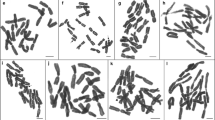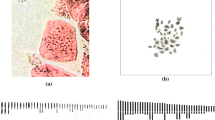Abstract
The karyotype analysis ofPeumus boldus reveals a remarkable differentiation of chromosomes in size and form. C-banding pattern and interphase nuclei are discribed and compared with other genera. The great variation in leaf-shape and growth-form is continuous and correlated with the very diverse habitats of the species. The recognition of infraspecific taxa is therefore not recommended. The lower leaf surface is very uniform within the monotypic genus and ± similar with that ofSiparuna. The different evolutionary strategies ofPeumus and related genera are discussed and show a different eco-systematic situation than inMollinedia andSiparuna.
Similar content being viewed by others
Literaturverzeichnis
Barthlott, W., Ehler, N., 1977: Raster-Elektronenmikroskopie der Epidermis-Oberflächen von Spermatophyten. — Tropische und subtropische Pflanzenwelt19. — Wiesbaden: Akademie der Wissenschaften und Literatur Mainz; Steiner-Verlag.
Berry, E. W., 1929: Tertiary fossil plants from the Argentine Republic. — Proc. U.S. Nat. Mus.73, art. 22.
, 1935: TheMonimiaceae and a newLaurelia. — Bot. Gaz.96, 751–754.
Brandham, P. E., 1974: Interchange and inversion polymorphism among populations ofHaworthia reinwardtii var.chalumnensis. — Chromosoma (Berlin)47, 85–108.
Brighton, C. A., 1978: Telocentric chromosomes in CorsicanCrocus L. (Iridaceae). — Pl. Syst. Evol.129, 299–314.
Ehrendorfer, F., 1970: Evolutionary patterns and strategies in seed plants. — Taxon19, 185–195.
, 1968: Chromosome numbers and evolution in primitive Angiosperms. — Taxon17, 337–353.
, 1979: Variation on the population, racial, and species level in the primitive relic angiosperm genusDrimys (Winteraceae) in South America. — Pl. Syst. Evol.132, 53–83.
Gadella, Th. W. J., Kliphuis, E., Lindeman, J. C., Mennega, E. A., 1969: Chromosome numbers and seedling morphology of some Angiospermae collected in Brazil. — Acta Bot. Neerl.18, 74–83.
Garatt, G. A., 1934: Systematic anatomy of the woods of theMonimiaceae. — Trop. Woods39, 18–43.
Goldblatt, P., 1974: A contribution to the knowledge of cytology inMagnoliales. — J. Arn. Arb.55, 453–457.
Greilhuber, J., Speta, F., 1976: C-banded karyotypes in theScilla hohenackeri group,S. persica andPuschkinia (Liliaceae). — Pl. Syst. Evol.126, 149–188.
Guerra Filho, M., 1980: Karyosystematik und Evolution derRutaceae. — Diss. Phil. Fak. Univ. Wien.
Hegnauer, R., 1969: Chemotaxonomie der Pflanzen5. — Basel und Stuttgart: Birkhäuser.
Heusser, C. J., 1971: Pollen and Spores of Chile. — Tucson, Arizona: The University of Arizona Press.
Hickey, L. J., Wolfe, J. A., 1975: The bases of Angiosperm phylogeny: Vegetative morphology. — Ann. Missouri Bot. Gard.62, 538–589.
Himmelbaur, W., 1931–1933: Drogenpflanzen, I. Alkaloiddrogen. InHanning, E., Winkler, H., (Eds.): Die Pflanzenareale, 3. Reihe, Heft 3.
Hobein, M., 1889: Beitrag zur anatomischen Charakteristik derMonimiaceae. — Bot. Jahrb.10, 51–74.
Hueck, K., 1966: Die Wälder Südamerikas. — Stuttgart: G. Fischer.
Hummel, K., 1962: Die Verbreitung der Haartypen in den natürlichen Verwandtschaftsgruppen. — InZimmermann, W., Ozenda, P. G., (Eds.): Handbuch der Pflanzenanatomie4/5. — Berlin Nikolassee: Gebr. Borntraeger.
Jones, K., 1977: The role of Robertsonian change in karyotype evolution in higher plants. — InDe la Chapelle, A., Sorsa, M., (Eds.): Chromosomes Today6, 121–129. — Amsterdam-New York-Oxford: Elsevier/North Holland Biomedical Press.
Khosla, P. K., Styles, B. T., 1975: Karyological studies and chromosomal evolution inMeliaceae. — Silvae Genet.24, 73–83.
Kunkel, G., 1956: Busch und Wald in Südchile. — Willdenowia1, 563–572.
Levin, D. A., Funderburg, S. W., 1979: Genome size in Angiosperms: Temperate versus tropical species. — Am. Nat.114, 784–795.
Levitsky, G. A., 1931: The “karyotype” in systematics. — Bull. Appl. Bot. Gen. Pl. Breed.27, 182–240.
Marks, G. E., 1975: The Giemsa staining centromers ofNigella damascena. — J. Cell Sci.18, 19–25.
Metcalf, C. R., Chalk, L., 1950: Anatomy of the Dicotyledons, Vol. I & II. — Oxford: Clarendon Press.
Money, L. L., Bailey, I. W., Swamy, B. G. L., 1950: The morphology and relationships of theMonimiaceae. — J. Arn. Arb.31, 372–404.
Morawetz, W., 1980: Morphologisch-ökologische Differenzierung, Biologie, Systematik und Evolution der neotropischen GattungJacaranda (Biognoniaceae). — Diss. Phil. Fak. Univ. Wien.
Okada, H., 1975: Karyomorphological studies of woodyPolycarpicae. — J. Sci. Hiroshima Univ. Ser. B., Div. 2, Bot.15, 115–200.
Pax, F., 1891:Monimiaceae. — InEngler, A., Prantl, K., (Eds.): Die natürlichen Pflanzenfamilien. — Leipzig: W. Engelmann.
Perkins, J., Gilg, E., 1901:Monimiaceae. — InEngler, A., (Ed.): Das Pflanzenreich. — Leipzig: W. Engelmann.
Reiche, K., 1907: Grundzüge der Pflanzenverbreitung in Chile. InEngler, A., Drude, O., (Eds.): Die Vegetation der Erde8. — Leipzig: W. Engelmann.
Sauer, W., Ehrendorfer, F., 1970: Chromosomen, Verwandtschaft und Evolution tropischer Holzpflanzen, II.Himantandraceae. — Österr. Bot. Z.118, 38–54.
Schindler, H., 1957:Peumus boldus Mol., die Stammpflanze der Folia Boldo. — Arzneim. Forsch.7, 747–753.
Schmithüsen, J., 1954: Waldgesellschaften des nördlichen Mittelchile. — Vegetatio5–6, 479–486.
Schodde, R., 1969: A Monograph of the FamilyAtherospermataceae. — Diss. Phil. Fak. Univ. Adelaide.
Schweizer, D., Ehrendorfer, F., 1976: Giemsa banded karyotypes, systematics, and evolution inAnacyclus (Asteraceae — Anthemideae). — Pl. Syst. Evol.126, 107–148.
Solereder, H., 1899: Systematische Anatomie der Dicotyledonen. — Stuttgart: F. Enke.
Stebbins, G. L., 1938: Cytological characteristics associated with the different growth habits in the dicotyledons. — Amer. J. Bot.25, 189–198.
Stone, D. E., Freeman, J. L., 1968: Cytotaxonomy ofIllicium floridanum andI. parviflorum (Illiciaceae). — J. Arn. Arb.49, 41–51.
Styles, B. T., Khosla, P. K., 1976: Cytology and reproductive biology ofMeliaceae. — InBurley, J., Styles, B. T., (Eds.): Tropical Trees, Variation, Breeding and Conservation. — London: Academic Press.
Tanaka, R., Okada, H., 1972: Karyological studies in four species ofAnnonaceae, a primitive angiosperm. — J. Sci. Hiroshima Univ. Ser. B., Div. 2, Bot.14, 85–105.
Tschermak-Woess, E., 1963: Strukturtypen der Ruhekerne von Pflanzen und Tieren. — Wien: Springer.
Tschischow, N. T., 1956: Número de chromosomas de algunas plantas chilenas. — Bol. Soc. Biol. Concepción (Chile)31, 145–147.
Author information
Authors and Affiliations
Rights and permissions
About this article
Cite this article
Morawetz, W. Karyologie und ökologisch-morphologische Differenzierung vonPeumus boldus (Monimiaceae, Laurales). Pl Syst Evol 138, 157–173 (1981). https://doi.org/10.1007/BF00985180
Received:
Issue Date:
DOI: https://doi.org/10.1007/BF00985180




